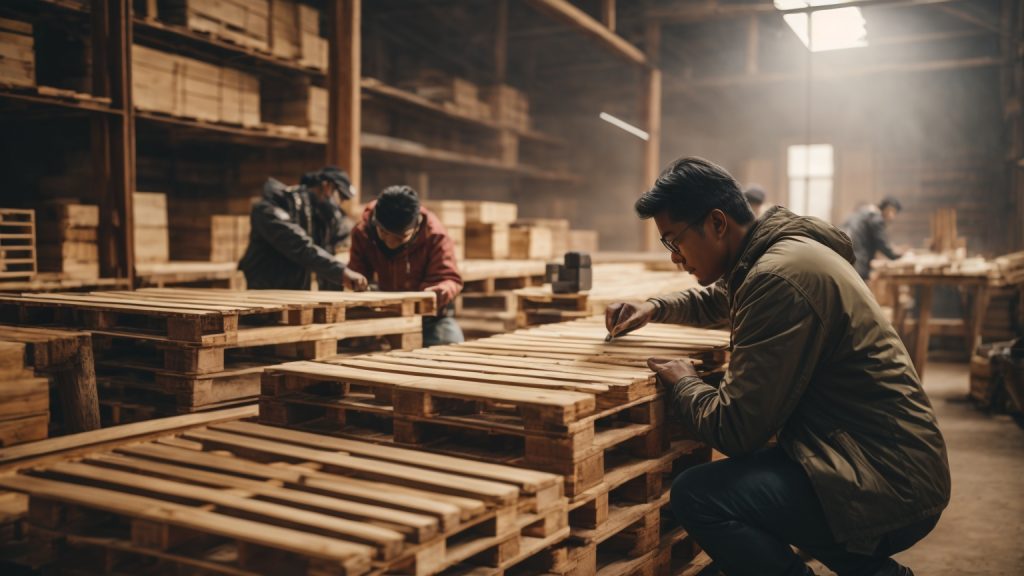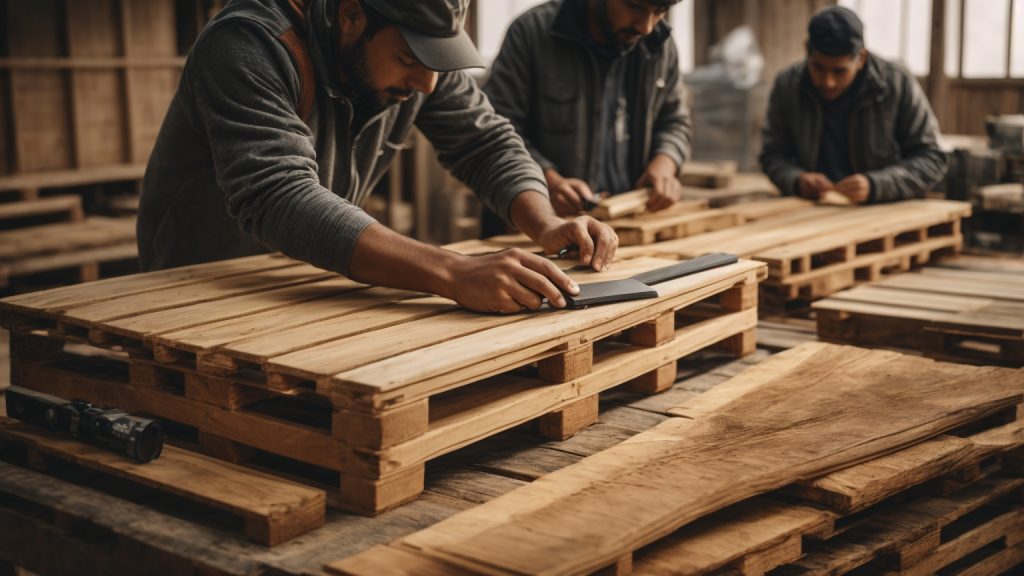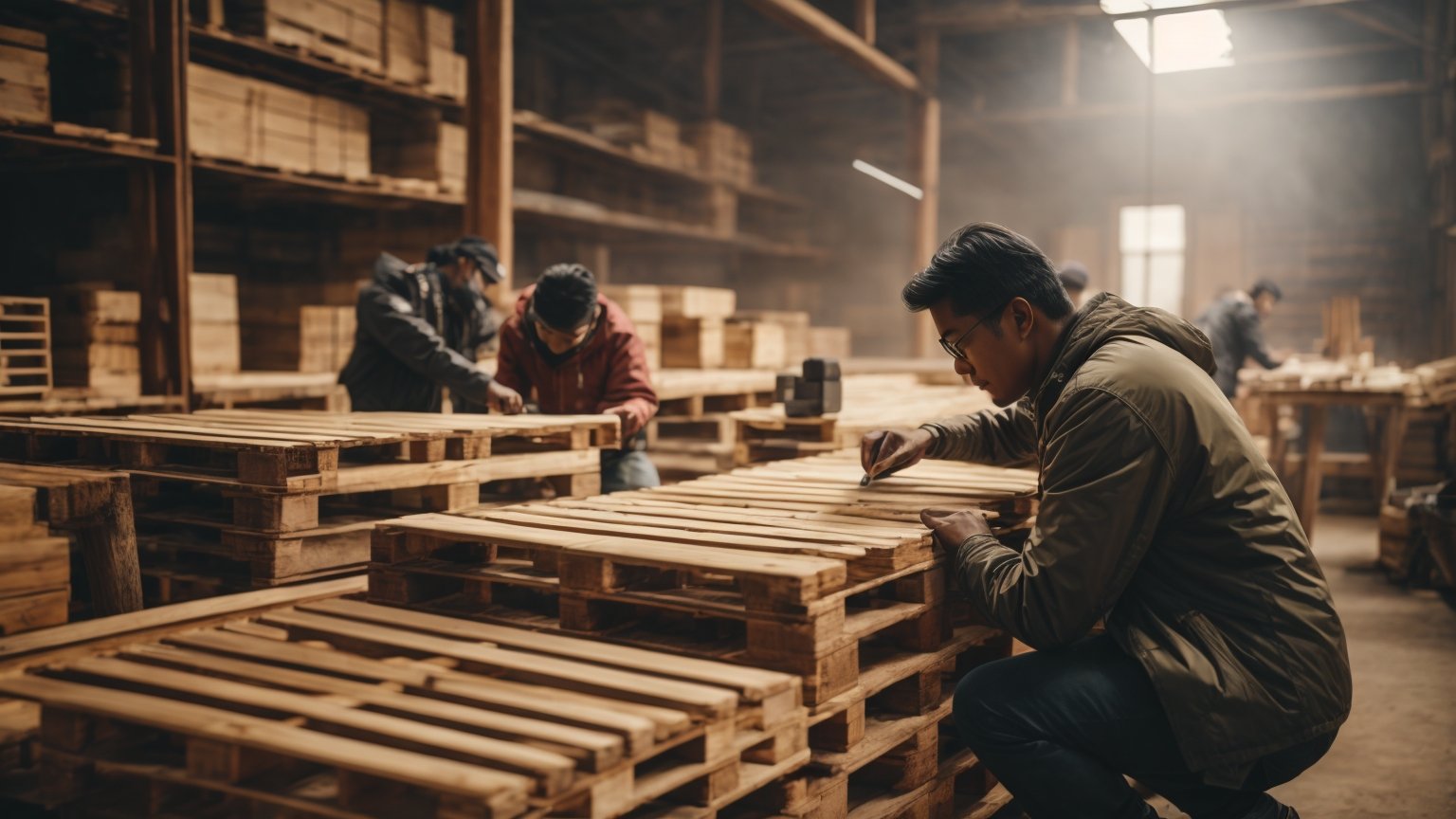If you’re looking to build your own furniture or create a unique DIY project, wooden pallets can be a great material to work with. Not only are they affordable and easy to find, but they can also be customized to fit your specific needs and style. In this article, we’ll walk you through the process of making your own wooden pallets, so you can start creating your own one-of-a-kind pieces.
Before we get started, it’s important to note that there are two types of pallets: chemically treated and heat treated. Chemically treated pallets are often used for shipping and can contain harmful chemicals, so it’s best to avoid using them for DIY projects. Heat treated pallets, on the other hand, are treated with heat to kill any pests and are safe to use for furniture and other projects. It’s important to look for the “HT” stamp on the pallet to ensure it’s safe to use. Once you have your heat treated pallets, you’re ready to start building!
Understanding the Basics of Pallet Making

If you are interested in making wooden pallets, it is important to understand the basics of pallet making. Pallets are typically made from a combination of softwood and hardwood, with oak and pine being popular choices. Here are some key factors to consider when making wooden pallets:
Wood Selection
When selecting wood for your pallets, you should consider factors such as strength, availability, and cost. Most pallets are made from softwood and hardwood, with the choice of wood depending on the intended use of the pallet. Oak is a strong and widely available hardwood, while pine is a popular and relatively affordable softwood.
Size and Trim
The size of your pallet will depend on its intended use. Pallets are typically either 48×40 inches or 42×42 inches, but custom sizes can be made as well. Once you have determined the size of your pallet, you will need to trim the wood to the appropriate length.
Deck Boards and Stringers
The deck boards and stringers are the main components of a pallet. Deck boards are the top and bottom boards that support the load, while stringers are the boards that run perpendicular to the deck boards and provide support. The size and spacing of the deck boards and stringers will depend on the intended use of the pallet.
Notches and Fasteners
Notches can be cut into the stringers to allow forklifts or pallet jacks to easily lift and move the pallet. Fasteners such as nails or screws are used to hold the pallet together. It is important to use the appropriate fasteners and to ensure that they are properly secured to prevent the pallet from breaking apart during use.
By understanding the basics of pallet making, you can create strong and durable pallets that are suitable for a variety of applications.
Materials Required
If you’re planning to make wooden pallets, you will need a few essential materials. In this section, we will discuss the types of wood and other materials required to make wooden pallets.
Types of Wood
The type of wood you choose for your pallets will depend on your budget, the purpose of the pallets, and the availability of the wood. Here are a few common types of wood used in making pallets:
- Softwood: Softwood is the most common type of wood used in making pallets. It is affordable and readily available. Pine is a popular softwood used in making pallets.
- Hardwood: Hardwood is more durable than softwood but is also more expensive. Oak is a popular hardwood used in making pallets.
- Mixed Wood: Most pallets are made of a mixture of softwood and hardwood. This is because pallet manufacturers cannot always specify the type of wood used in making the pallets.
Other Essential Materials
Apart from the wood, you will also need a few other essential materials to make wooden pallets. Here are a few of them:
- Nails: You will need nails to hold the pallet together. Make sure to use nails that are long enough to go through the wood and hold it securely.
- Saw: You will need a saw to cut the wood to the desired size and shape.
- Hammer: You will need a hammer to drive the nails into the wood.
- Measuring Tape: You will need a measuring tape to measure the wood accurately.
- Pencil: You will need a pencil to mark the wood before cutting it.
- Safety Equipment: You will need safety equipment such as gloves and safety glasses to protect yourself while working with the wood.
By having all the necessary materials on hand, you can make your own wooden pallets and save money in the process.
Choosing the Right Wood
When it comes to making wooden pallets, choosing the right type of wood is crucial. The right wood will ensure that your pallets are durable, sturdy, and able to withstand the weight of the products they are carrying. Here are some factors to consider when choosing the right wood for your pallets:
Hardwood vs. Softwood
Most pallet manufacturers prefer to use hardwood for making pallets. This is because hardwood is denser and more durable than softwood, which makes it better suited for heavy-duty applications. However, softwood can also be used for making pallets, especially if the pallets are intended for lighter loads.
Location and Availability
The type of wood you choose for your pallets will also depend on your location and the availability of different types of wood in your area. For example, if you live in an area with a lot of pine trees, it may be more cost-effective to use pine wood for your pallets instead of importing hardwood from another region.
Intended Use
The intended use of your pallets is another important factor to consider when choosing the right wood. If your pallets will be used for outdoor storage or transportation, you may want to choose a type of wood that is more resistant to moisture and rot, such as cedar or redwood. On the other hand, if your pallets will be used for indoor storage or transportation, you may not need to worry as much about moisture resistance.
Other Considerations
In addition to the factors mentioned above, there are a few other things to consider when choosing the right wood for your pallets:
- Size: Make sure the wood you choose is the right size for your pallets.
- Strength: Choose wood that is strong enough to support the weight of your products.
- Sustainability: Consider using wood that is sustainably sourced to reduce your environmental impact.
By considering these factors when choosing the right wood for your pallets, you can ensure that your pallets are strong, durable, and able to meet your specific needs.
Pallet Designing
When it comes to designing pallets, there are two main options: standard sizes and custom designs.
Standard Pallet Sizes
Standard pallet sizes are widely used in the industry and can be easily sourced from manufacturers. The most common sizes are:
| Size | Dimensions (inches) |
|---|---|
| 48×40 | 48 x 40 x 6 |
| 42×42 | 42 x 42 x 6 |
| 48×48 | 48 x 48 x 6 |
These sizes are popular because they are compatible with most pallet jacks and forklifts. They are also easy to stack and transport.
Custom Pallet Designs
Custom pallet designs are an option for those who need a specific size or shape that is not available in standard sizes. When designing a custom pallet, there are several factors to consider:
- Load capacity: Determine the weight and size of the items that will be placed on the pallet to ensure it can handle the load.
- Material: Choose the appropriate type of wood or other material based on the intended use of the pallet.
- Durability: Consider the expected lifespan of the pallet and choose materials and design elements that will ensure longevity.
- Compatibility: Ensure the pallet is compatible with the machinery that will be used to move and transport it.
Custom pallets can be designed in a variety of shapes and sizes, including circular, triangular, and hexagonal. They can also be designed with additional features such as notches, grooves, and handles for easier handling.
Overall, whether you choose a standard size or a custom design, it’s important to consider the specific needs of your business and the intended use of the pallet. With the right design, pallets can be a valuable asset for your operations.
Cutting the Wood
Now that you have chosen your wood, it’s time to cut it into the proper-sized deck boards and stringers for your pallet. Here are the steps to follow:
- Trim the cants: Pallet cants from local sawmills are trimmed to the proper length before being ripped into boards. The length of the cants will depend on the size of the pallet you want to make.
- Rip into boards: Once the cants are trimmed, they are then ripped into boards of the proper width. The width will depend on the type of pallet you want to make.
- Sawn into deck boards and stringers: After the boards are ripped, they are sawn into deck boards and stringers that will fit the type of pallet being used.
- Cut notches into stringers: The next step is to cut notches into stringers. This allows for 4-way entry using forklifts, or 2-way entry using pallet jacks.
When cutting the wood, it’s important to take safety precautions. Always wear protective gear, such as safety glasses and gloves, and ensure that the saw blade is sharp and in good condition. It’s also important to make sure the wood is securely held in place while cutting to avoid accidents.
By following these steps, you can cut the wood for your pallet with ease and precision.
Assembling the Pallet

Now that you have all the necessary materials, it’s time to assemble your wooden pallet. Here are the steps you need to follow:
- Lay out the bottom deck of the forklift by placing two 5-1/2 by 40 by 5/8 inch crosspiece boards on the ground. Mount one flush with each end of the two outside stringers. Nail the third stringer parallel to the others in the middle. Use nine nails per 5-1/2 inch crosspiece, three at each joining.
- Once the bottom deck is complete, lay the top deck on top of it and secure it with nails or screws. Make sure to align the boards of the top deck with those of the bottom deck.
- Next, attach the blocks to each corner of the pallet. These blocks will help distribute the weight of the load and prevent the pallet from collapsing.
- Finally, attach the optional stringers to the bottom of the pallet. These stringers will provide additional support and stability to the pallet.
Remember to use the appropriate safety gear, such as gloves and safety glasses, when assembling your pallet. Also, make sure to inspect your pallet for any defects or damage before using it. With these simple steps, you can create a sturdy and reliable wooden pallet that will serve your needs for years to come.
Finishing the Pallet
Once you have assembled your wooden pallet, it’s time to give it a finishing touch. Finishing a pallet is important not only for aesthetic reasons but also to protect the wood from weathering and deterioration. In this section, we will cover two important steps in finishing your pallet: sanding and sealing.
Sanding
Sanding is crucial to give your pallet a smooth and polished surface. Sanding will also help to remove any rough edges and splinters, making your pallet safe to handle. Here are some tips for sanding your pallet:
- Use a coarse-grit sandpaper (60-80 grit) to start sanding the surface of the pallet.
- Sand in the direction of the wood grain to avoid damaging the wood fibers.
- Once you have sanded the surface, use a finer grit sandpaper (120-150 grit) to smooth out the surface further.
- Sand the edges of the pallet to remove any rough edges and splinters.
- Use a tack cloth to remove any dust or debris left from sanding.
Sealing
Sealing your pallet is important to protect the wood from moisture and weathering. There are several options for sealing your pallet, including staining, painting, or using a clear sealant. Here are some tips for sealing your pallet:
- If you want to stain your pallet, choose a stain that is suitable for outdoor use and matches the color of your other outdoor furniture.
- If you want to paint your pallet, choose a paint that is suitable for outdoor use and matches the color of your other outdoor furniture.
- If you want to use a clear sealant, choose a sealant that is suitable for outdoor use and provides UV protection.
- Apply the sealant evenly with a brush or roller, making sure to cover all surfaces of the pallet.
- Allow the sealant to dry completely before using the pallet.
By following these tips for sanding and sealing your pallet, you can ensure that your pallet will look great and last for years to come.
Safety Precautions
When working with wooden pallets, it is important to take proper safety precautions to avoid injury. Here are some tips to keep in mind:
Wear Protective Gear
Wearing protective gear is crucial when working with wooden pallets. Safety equipment such as puncture-proof gloves, safety shoes, and clothing that covers your legs and arms will help protect you from slivers and other injuries.
Check the Condition of the Pallet
Before using a wooden pallet, make sure it is in good condition. Check for any broken or loose boards, protruding nails, or other damage that could cause injury. Do not use a damaged or underrated pallet.
Be Careful When Handling Pallets
When handling pallets, be sure to lift with your legs and not your back. Do not try to lift a pallet that is too heavy for you to handle safely. Use a pallet jack or forklift if necessary.
Avoid Hazardous Pallets
Some pallets are used to transport hazardous materials or may harbor bacteria. Avoid using these pallets for indoor projects, and be sure to take appropriate precautions when handling them.
Use Tools Safely
When cutting or sawing wooden pallets, be sure to use the appropriate tools and follow all safety guidelines. Wear eye protection and keep your hands and fingers away from the blade.
By following these safety precautions, you can work with wooden pallets safely and avoid injury.
Maintaining Your Wooden Pallets
Keeping your wooden pallets in good condition is important to ensure they last longer and can be reused. Here are some tips for maintaining your wooden pallets:
1. Store Pallets Properly
Storing your pallets correctly is essential to prevent damage and extend their lifespan. Keep them in a dry, cool place away from direct sunlight and moisture. You can stack them on top of each other, but make sure to place a layer of cardboard or other protective material between them to avoid scratches and damage.
2. Inspect Regularly
Inspect your pallets regularly to identify any damage or issues that need to be addressed. Check for cracks, splinters, loose boards, or any signs of rot or decay. If you notice any damage, remove the pallet from circulation and repair or replace it as needed.
3. Clean Pallets
Cleaning your pallets is essential to maintain their quality and hygiene. Use a soft-bristled brush or a pressure washer to remove any dirt, debris, or stains. Avoid using harsh chemicals or bleach as they can damage the wood and reduce its lifespan.
4. Treat Pallets
Treating your pallets can help protect them from moisture, insects, and other environmental factors that can cause damage. You can use a variety of treatments such as paint, stain, or sealant to protect the wood. Make sure to choose a treatment that is safe for the intended use of the pallet.
5. Handle with Care
When handling your pallets, make sure to do so with care to avoid damage. Use a forklift or pallet jack to move them around and avoid dragging them on the ground. Also, avoid overloading them beyond their weight capacity as it can cause damage and increase the risk of accidents.
By following these simple tips, you can maintain your wooden pallets and ensure they last longer and can be reused.
